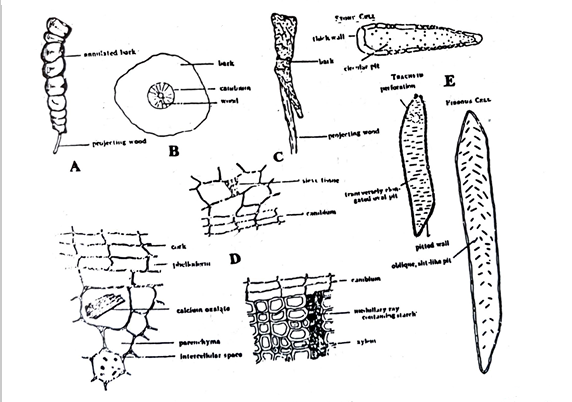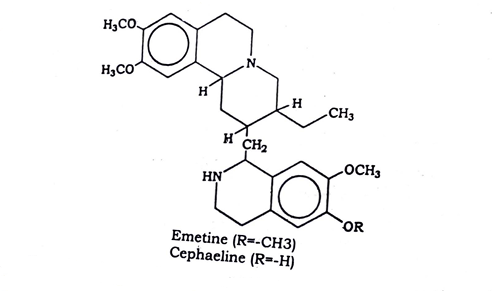Synonyms:
Ipecac, Ipecacuanha Root, Ipecacuanhae Radix.
Botanical source:
Ipecacuanha consists of the dried, enlarged adventitious roots and slender rhizomes of Cephaelts ipecacuanha (Brot.) A. Rich. of the family Rubiaceae.
Geographical source:
The drug is obtained from plants growing both wild and cultivated in the forests of Brazil. It has been successfully produced by cultivation in West Bengal, Burma, Singapore and Malaysia.

Fig 57: Ipecacuanha. A, root; B, transverse surface of root; C, stem; D, tissues in transverse section; E entire cellular elements from macerated tissues. (Rectructed from Hebert & Ellery).
Macroscopical Characters:
The root is tortuous and roughly cylindrical in shape. It occurs in pieces, 5 to 15 cm long and 4 to 6 cm thick. It is covered with an annulated bark, which is often separated completely from the wood. The bark is reddish brown to dark brown in colour and the wood is yellow. The drug has a short fracture usually with a characteristic fractured surface which is horny or starchy in the bark and splintery in the Wood. The transversely cut surface shows a distinct cambium, a Wide bark and a narrow, compact central wood. It has a slight odour and a bitter taste.
Microscopical characters:
The cork of the bark consists of tangentially elongated polygonal cells· containing a granular brown content. The cortical cells are parenchymatous with numerous small intercellular spaces. They contain much starch grains and occasional acicular raphides of calcium oxalate. The phloem occurs as sedge shaped groups around the wood. The xylem tissue consists of lignified pitted tracheids; long narrow obliquely pitted and thick walled fibrous cells (not typical fibres), and elongated lignified cells of medullary rays. Simple or compound starch grains with well-marked hila occur in the xylem tissues.
Chemical constituents:
Ipecacuanha contains 2 to S percent of total alkaloids, which include emetine (about 70 percent cephaelme (bout 30 percent), psychotrine, methyl psychotrine and emctamme. it also contains a glycoside ipecacuanhic acid starch and calcium oxalate.

Uses: The drug is mainly used as an expectorant and emetic, and as a remedy for amoebic dysentery. It also possesses diaphoretic and cholagogue properties.
Substitutes and adulterants:
The common substitutes and adulterants of Ipecacuanha include the dried roots and rhizomes of Psychotria acuminata (Cartagena Ipecacuanha), Psychotria emetica, Richardsonia scabra (Undulated Ipecacuanha) Manettia ignita and Ionidium ipecacuanha (White Ipecacuanha).

